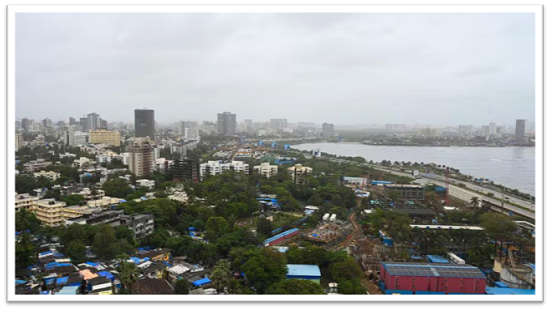
Bandra Bay Rising: Mumbai’s 1 Lakh Crore Coastal Makeover Set to Redefine Urban Luxury
Mumbai’s western coastline is preparing for a transformation of historic scale. The Bandra Reclamation precinct, once a modest government housing colony, is set to be reborn as “Bandra Bay,” a high-end waterfront district promising luxury towers, a marina, and world-class urban infrastructure. Estimated at over ₹1 lakh crore in redevelopment value, the project is poised to reshape the city’s skyline, economy, and social fabric.
The Maharashtra government’s cluster redevelopment initiative, announced earlier this year under the guidance of IAS Sanjeev Jaiswal, envisions replacing 52 ageing MHADA buildings, originally constructed for government employees, with over 8 million sq. ft. of premium real estate. Developers have been offered a generous Floor Space Index (FSI) of 4, along with relaxed consent norms — only 51% resident approval is now required per colony. Authorities believe this approach will accelerate redevelopment, generate modern housing stock, and attract major private investment.
Yet, as cranes and contracts multiply, questions about displacement, environmental risk, and urban equity loom large. Critics argue that the city’s push toward vertical luxury is coming at the cost of its ecological and social foundations.
The Making of ‘Bandra Bay’
Stretching from Nargis Dutt Nagar to Nityanand Nagar, the project spans some of Mumbai’s most valuable coastal real estate. Developers such as Oberoi Realty, Godrej Properties, Adani Realty, Hiranandani Communities, L&T Realty, The Wadhwa Group, and Excel Group are already engaged in various stages of planning and acquisition.
The reimagined district aims to rival global icons like Dubai Marina and Singapore Bayfront, with mixed-use zoning for residences, hospitality, sports, and recreation. Planned features include a five-star hotel, a health hub, a marina, and sports infrastructure such as a cricket academy, shooting range, and athletics track. Urban planners describe it as “a city within a city”, a self-contained ecosystem of luxury living and leisure by the sea.
A Regulatory Shift with Far-Reaching Impact
A critical enabler of this redevelopment has been the government’s reclassification of coastal stretches like Mahim and Backbay as “bays” rather than “seafronts.” This technical change drastically reduces the no-development zone from 500 metres to just 50 metres, effectively unlocking prime land for construction.
While developers hail the move as a pragmatic response to Mumbai’s housing and infrastructure needs, environmentalists warn it could accelerate coastal erosion, weaken flood resilience, and disrupt the city’s already vulnerable marine ecosystem. “We are trading long-term environmental safety for short-term economic gain,” said an urban ecologist based in Mumbai.
Residents Caught Between Aspiration and Anxiety
For the thousands of MHADA residents who currently occupy Bandra Reclamation’s government quarters, the redevelopment has brought both hope and uncertainty. Under the proposed Build-Finance-Operate-Transfer (BFOT) model, MHADA incurs no upfront cost while ensuring that existing tenants receive modern apartments.
The new homes, ranging from 829 sq. ft. to 1,615 sq. ft., are a significant upgrade from the current 322–825 sq. ft. units. However, several residents remain unconvinced. Members of local associations allege they were not adequately consulted and fear displacement during the multi-year construction period. “Our homes are still livable. We are not against development, but it should not happen without dialogue,” one resident said.
The reduction in the required consent percentage has also raised concerns. Critics argue it tilts the balance of power heavily toward developers, undermining community participation and transparency in decision-making.
Big Developers, Bigger Stakes
Even before formal clearances, land transactions in Bandra Reclamation have intensified. Adani Realty has reportedly acquired a 24-acre plot from the Maharashtra State Road Development Corporation, valued at nearly ₹30,000 crore. Larsen & Toubro and Valor Estate are collaborating on an ₹8,500 crore redevelopment along Bazaar Road, while multiple smaller societies near Lilavati Hospital have begun demolition planning.
These moves underline the area’s emerging status as Mumbai’s next ultra-premium destination. The combination of proximity to Bandra-Kurla Complex, sea views, and improved connectivity through the Coastal Road project makes Bandra Bay a magnet for luxury real estate investment.
The Cost of Aspiration
The redevelopment of Bandra Reclamation is emblematic of India’s broader urban transformation, an ambitious leap from public housing to private skyline. It reflects a policy shift that prioritizes land optimization and private capital as engines of renewal.
Yet, it also exposes the contradictions of this approach. The same land that once symbolized post-independence welfare housing now represents the aspirations of a globalized cityscape. The state’s role as both regulator and beneficiary complicates the narrative, balancing economic growth with social justice and environmental stewardship.
Urbanists warn that without strong safeguards, Mumbai’s coastlines could become enclaves of privilege, disconnected from the city’s working and middle classes. “Redevelopment must not just be about height and glass. It must preserve diversity, affordability, and ecology,” noted a senior urban planner.
Future at the Water’s Edge
As bulldozers prepare to move in, Bandra Reclamation stands at the crossroads of vision and vulnerability. The success of Bandra Bay will depend not just on architectural grandeur but on how sensitively redevelopment integrates with the lives and livelihoods it transforms.
If executed with balance and transparency, this project could serve as a global model for sustainable coastal redevelopment, one that combines luxury with liveability, density with design, and profit with public purpose. But if driven purely by market logic, it risks becoming another example of exclusive urbanism, where the sea view is beautiful but the city beneath remains divided.
For Mumbai, the stakes go far beyond real estate. Bandra Bay will test whether India’s financial capital can build upward without eroding its social and environmental foundations, a question that will define not just a skyline, but a legacy.
